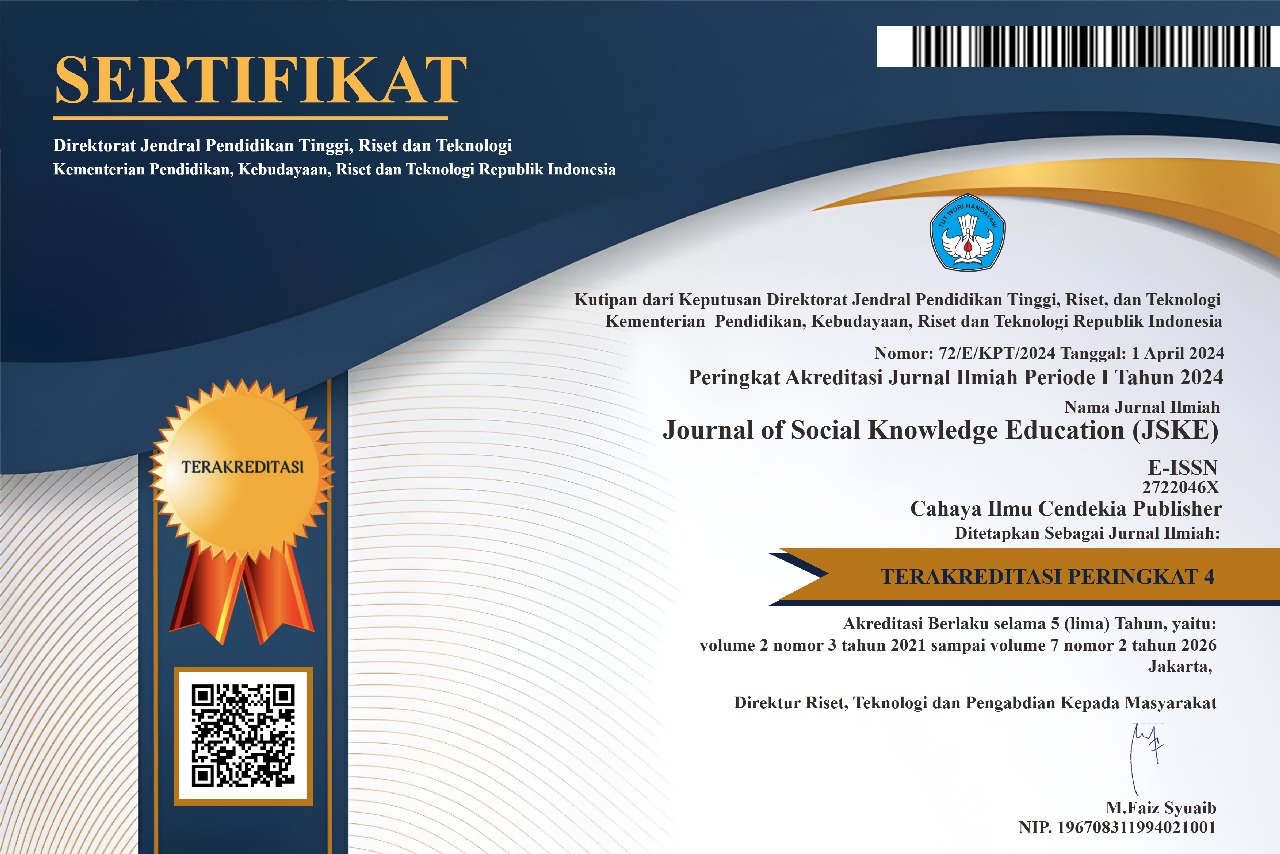Implementation of Character Education in History Learning
Abstract
The approach used in this study is a qualitative approach with purposive sampling of data sources. While the data collection techniques used include observation and interviews. The data analysis technique used is the Miles and Huberman method which includes data collection, data reduction, data presentation and verification. The results showed that (1) the history teacher's readiness in implementing character education was good by preparing the syllabus and lesson plans, (2) the implementation of character education was not optimal because the teacher had not included character education assessment instruments, but it was done well because it was in accordance with the syllabus and lesson plans that were inserted with an explanation of the values of the nation's character, (3) the obstacles experienced by teachers, namely: time is so short, the community environment is not conducive, electronic media, learning models, and costs to support character education activities, (4) perception and appreciation / student responses to the implementation of character education have been good as evidenced by good character and supported by the strictness of the rules from the school.
References
L. T. Suharni and F. Fachrudin, “Pengembangan Desain Pembelajaran dengan Model Assure di Sekolah Dasar,” J. basicedu, vol. 3, no. 3, pp. 976–982, 2019.
M. Silmi and Y. Kusmarni, “Menumbuhkan Karakter Rasa Ingin Tahu Siswa dalam Pembelajaran Sejarah Melalui Media Puzzle,” FACTUM J. Sej. dan Pendidik. Sej., vol. 6, no. 2, pp. 230–242, 2017, doi: 10.17509/factum.v6i2.9980.
Kuntowijoyo, Pengantar Ilmu Sejarah. Yogyakarta: Yayasan Bentang Budaya, 1995.
M. Baginda, “Nilai-Nilai Pendidikan Berbasis Karakter pada Pendidikan Dasar dan Menengah,” J. Ilm. Iqra’, vol. 10, no. 2, pp. 1–12, 2018, doi: 10.30984/jii.v10i2.593.
J. Saputri, “Pembelajaran Tematik: Komparasi Karakter Peduli Lingkungan dan Karakter Cinta Damai,” J. Basic Educ. Res., vol. 2, no. 3, pp. 79–83, 2021, doi: 10.37251/jber.v2i3.200.
R. Fitriani, Kholilah, E. F. S. Rini, A. Pratiwi, Maharani Rizky Ramadhanti, H. Syiarah, and H. Safitri, “Analisis Karakter Kerja Keras Siswa Kelas XI IPADi SMAN 1 Kota Jambi,” PENDIPA J. Sci. Educ. J. Sci. Educ., vol. 5, no. 2, pp. 188–194, 2021.
F. T. Aldila and E. F. S. Rini, “Teacher’s Strategy in Developing Practical Values of the 5th Pancasila Preepts in Thematic Learning in Elementary School,” J. Basic Educ. Res., vol. 4, no. 1, 2023.
M. M. Matondang, E. F. Setiya Rini, N. D. Putri, and F. Yolvianysah, “Uji Perbandingan Motivasi Belaajar Siswa Kelas XI MIPA 2 dan XII MIPA 2 di SMA Negeri 1 Muaro Jambi,” J. Sains dan Pendidik. Fis., vol. 16, no. 03, pp. 218–227, 2021, doi: https://doi.org/10.35580/jspf.v16i3.15553.
E. S. Cahyaningrum, S. Sudaryanti, and N. A. Purwanto, “Pengembangan Nilai-Nilai Karakter Anak Usia Dini Melalui Pembiasan dan Keteladan,” J. Pendidik. Anak, vol. 6, no. 2, pp. 203–213, 2017, doi: 10.26877/jo.v4i2.4005.
H. Supranoto, “Implementasi Pendidikan Karakter Bangsa Dalam Pembelajaran Sma,” PROMOSI (Jurnal Pendidik. Ekon., vol. 3, no. 1, pp. 36–49, 2015, doi: 10.24127/ja.v3i1.141.
Sugiyono, Metode Penelitian dan Pengembangan. Bandung: Alfabeta, 2015.
E. F. Setiya Rini, D. Darmaji, and D. A. Kurniawan, “Identifikasi Kegiatan Praktikum dalam Meningkatkan Keterampilan Proses Sains di SMPN Se-Kecamatan Bajubang,” Edukatif J. Ilmu Pendidik., vol. 4, no. 2, pp. 2476–2481, 2022, doi: 10.31004/edukatif.v4i2.2360.
M. B. Miles and A. M. Huberman, Qualitatif Data Analysis. SAGE Publications, 1994.
A. Wibowo, Pendidikan Karakter Strategi Membangun Karakter Bangsa Berperadaban. Yogyakarta: Pustaka Pelajar, 2012.
S. M. Ulfah, S. A. Wahyuni, and L. H. Hawasyi, “Nilai Tanggung Jawab sebagai Karakter Anak Negeri Melayu Jambi yang Bersendikan Syara’ dan Syara’ Bersendikan Kitabullah,” SMART KIDS J. Pendidik. Islam Anak Usia Dini, vol. 1, no. 1, pp. 1–8, 2019, doi: 10.30631/smartkids.v1i1.41.
N. N. Simamora, W. A. Putri, M. Iqbal, A. Ramadhanti, and E. F. S. Rini, “Description of Student Discipline Attitudes at SMP Negeri 16 Jambi City,” Lensa J. Kependidikan Fis., vol. 8, no. 2, p. 76, 2020, doi: 10.33394/j-lkf.v8i2.3175.
A. Ramadhanti, N. N. Simamora, E. Febri, S. Rini, and R. Fitriani, “Deskripsi Motivasi Belajar Fisika Siswa Kelas X MIPA di SMAN 1 Kota Jambi,” J. Eval. Educ., vol. 3, no. 3, pp. 82–86, 2022, doi: 10.37251/jee.v3i3.245.
Copyright (c) 2023 Diah Karmina, Katerina Dalakoura, Lydiah Njoki Wachira

This work is licensed under a Creative Commons Attribution-NonCommercial 4.0 International License.
Authors who publish with this journal agree to the following terms:
- Authors retain copyright and acknowledge that the Journal of social knowledge education (JSKE) is the first publisher licensed under a Creative Commons Attribution 4.0 International License.
- Authors are able to enter into separate, additional contractual arrangements for the non-exclusive distribution of the journal's published version of the work (e.g., post it to an institutional repository or publish it in a book), with an acknowledgment of its initial publication in this journal.
- Authors are permitted and encouraged to post their work online (e.g., in institutional repositories or on their website) prior to and during the submission process, as it can lead to productive exchanges and earlier and greater citation of published work.






.png)
.png)















